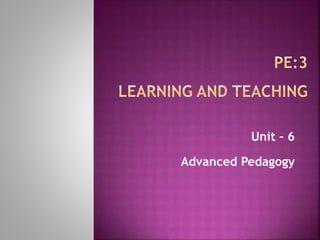
Cooperative Learning
- 1. Unit – 6 Advanced Pedagogy
- 2. Principles Techniques Process Classroom Implications
- 3. Cooperative learning is an instructional strategy where small team of students, usually two to six members, work together to maximize their individual and collective learning. Cooperative learning is a strategy where students can work on linguistic skills and academic skills at the same time. In this strategy the students work together in small groups.
- 4. Artz & Newman (1990), “Cooperative learning is defined as small groups of learners working together as a team to solve problem, complete a task, or accomplish a common goal.”
- 5. Cooperative learning is a successful teaching strategy in which small teams, each with students of different levels of ability, use a variety of learning activities to improve their understanding of a subject, each member of a team is responsible not only for learning what is taught but also for helping teammates learn. Thus creating an atmosphere of achievement, students work through the assignment until all group members successfully understand and complete it.
- 6. it is delivering instruction through small groups, empowering students to work together to build their understanding of topics and concepts.
- 7. 1. Positive Interdependence 2. Promotive Interaction 3. Accountability 4. Soft skills Instruction 5. Group Processing
- 8. Positive Interdependence Students must see that each group member’s effort are important to both individual and team success. Promotive Interaction Students must empower each other by offering help, praise, feedback and resources.
- 9. Accountability Each student must accept responsibility for fulfilling his or her role, helping the team reach its learning goals.
- 10. Soft Skills Instruction Because students need to develop interpersonal skills to effectively work together, you should give lessons and activities about teamwork. Group Processing As a group, students should strategize how to meet their learning goals.
- 11. Jigsaw Each member of a five or six member heterogeneous group is responsible for mastering a portion of the material and then teaching that part to the other team members. Group Investigation Students are involved in planning the group topics as well as the ways in which they will proceed with their investigation. once Students select topic for study, they conduct in depth investigations and then prepare and present a report to the whole class.
- 12. Think, Pair and Share Students spend a few minutes thinking individually about a solution to a problem posed by the teacher, then discuss the ideas with their peer before sharing their ideas with the whole group.
- 13. Numbered Heads Together A team of four is established. Each member is given a number of 1,2,3,4. questions are asked and groups work together. Teacher calls out a number (two) and each two is asked to give the answer.
- 14. Six key steps for cooperative learning: 1. Choose an approach 2. Choose appropriate content 3. Form student teams 4. Develop materials 5. Plan for orienting students to ask and roles 6. Plan for the use of time and space
- 15. It promotes self esteem and make students feel better about themselves, school and others. It promotes higher achievement, develops social skills including listening, taking turns, conflict resolution skills, leadership skills and team work. It teaches students to cooperate with others and do their best.
- 16. It welcomes students to benefit from their classmate’s knowledge and thoughts. It protects less capable students from impossible challenges. It facilitates problem solving skills and creativity. It leads to more relaxed atmosphere, greater motivation and increased student talk.
- 17. It makes student appreciate differences and diversity. It removes damaging competition between and among students and creates competition among groups. It builds empathy i.e. understanding and appreciating the point of view and feeling of others, being considerate of others.
- 18. It leads to equal and increased participation. It creates the feeling that “Alone we are stuck; in interaction we grow” It prepares students for the interdependence team based workplace of the 21st century.